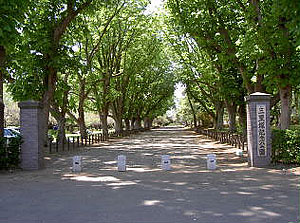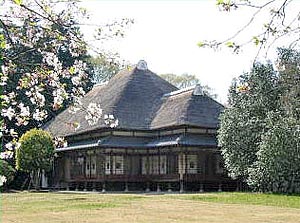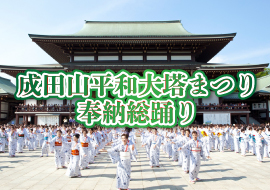It is the text from here.
Sanrizuka Park

The origin of the place name called "Sanrizuka"…
Because it was said, "I am located of the castle of Sakura to three villages", this ground became able to call "located of the temple called the Nichiren sect Japan temple (ニチホンジ) in Tako-machi, Katori-gun to three villages" with "Sanrizuka".
By the way, the Japanese temple made the Lotus sutra mound in 17 places until the Edo era, but, in one village, in Somei, two villages, in the white measure, three villages, in Sanrizuka, four villages, the Lotus sutra mound, five villages are temple stands…. "Sanrizuka" is called as the place name with the third place meaning, and I follow at the present.
 "The Imperial Household Agency Shimousa Imperial Stock Farm" was in Sanrizuka before airport construction and showed the turnout in many customers from not only the neighborhood but also the distant place as a famous spot for its cherry blossoms by Sakuragi who was said to be 100,000 when it was spring. Sanrizuka Memorial Park is proud of the very large site of 30,000 square meters in a part of ruins of the Imperial Household Agency Shimousa Imperial Stock Farm. When a ranch is established, the reason why a lot of cherry trees are planted has been planted other than a cedar or a pine for a storm, but, as for beginning, it seems to be about time when this ground was ranch "取香牧" of the horse of the Shogunate direct control in the Edo era.
"The Imperial Household Agency Shimousa Imperial Stock Farm" was in Sanrizuka before airport construction and showed the turnout in many customers from not only the neighborhood but also the distant place as a famous spot for its cherry blossoms by Sakuragi who was said to be 100,000 when it was spring. Sanrizuka Memorial Park is proud of the very large site of 30,000 square meters in a part of ruins of the Imperial Household Agency Shimousa Imperial Stock Farm. When a ranch is established, the reason why a lot of cherry trees are planted has been planted other than a cedar or a pine for a storm, but, as for beginning, it seems to be about time when this ground was ranch "取香牧" of the horse of the Shogunate direct control in the Edo era.
Why was the Imperial Stock Farm prepared into Sanrizuka of Narita here? A question called this came out, but it was necessary that Japan enhanced production of wool by the Westernization of the Meiji era.
In addition, European Toshimichi Okubo who studied abroad thought that a meal was related to the Japanese body not being bigger than a European in those days and thought that production of oxen and horses was urgent business.
Therefore it was ranch establishment that Toshimichi Okubo who came home from studying abroad worked at the very beginning. As a result of inviting an American expert as the government, and having repeated examination on the site choice of the "Shimousa sheepcote" that was a forerunner of the Shimousa Imperial Stock Farm "Tokko breeding stock farm", 1 provided the condition of three of the convenience for supplies transportation 3 that was endowed with the forest place 2 to be rich to green grass. It goes without saying that around Sanrizuka area included natural environments and geographical environment meeting these conditions.
The Shimousa Imperial Stock Farm was paid attention to as existence of the pioneer including "the birthplace of the Mongolian mutton barbecue" "the Japanese horse racing birthplace" "the Japanese veterinary birthplace" "the birthplace of the dairy farming in Japan".
Leading sires called ダイオライト where it is the Showa era and left a wonderful grade for in the U.K. at the time are imported, and the race horse of the child becomes the first Japanese Triple Crown winner. A monument of ダイオライト and トゥルヌソル is left in Sanrizuka Memorial Park and is telling you now how it was the leading sire which had a big influence.

Figure in bronze of the Derby horse Hisa attendant

Monument of ダイオライト and トゥルヌソル
 In Other, as for the wooden thatched one-story house, appearance, there is Japanese style, "the Goryobokujo, Sanrizuka, Narita-shi memorial hall" where building "distinguished guest building" and the information about Meiji in the middle compromise between Japanese and European styles style called the internal Western style were displayed in the park, and a literature monument of Yoshu Mizuno and Koutarou Takamura of the deep writer of the relationship is built in Narita.
In Other, as for the wooden thatched one-story house, appearance, there is Japanese style, "the Goryobokujo, Sanrizuka, Narita-shi memorial hall" where building "distinguished guest building" and the information about Meiji in the middle compromise between Japanese and European styles style called the internal Western style were displayed in the park, and a literature monument of Yoshu Mizuno and Koutarou Takamura of the deep writer of the relationship is built in Narita.
[access]
- JR bus ride (JR Narita Station Central Exit 1.2 turn bus platform) for "Yokaichiba" for "Sanrizuka", "Sanrizuka" getting off. A 1-minute walk.
JR bus Yokaichiba - Tako stand BT - Narita Airport - Narita Airport - JR Narita Station line timetable
http://www.jrbuskanto.co.jp/bus_etc/timetable.html (External link)
[Sanrizuka Goryo Ranch Memorial Hall]
To "Narita International Airport" ← [the highlight information] → To "Sogo Reido Sanctuary"
成田市観光協会 Copyright (C) Narita City Tourism Association. All Rights Reserved.





